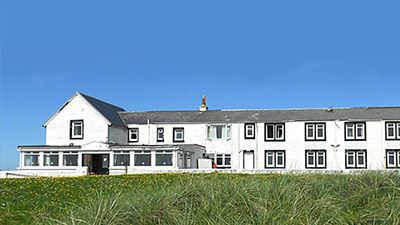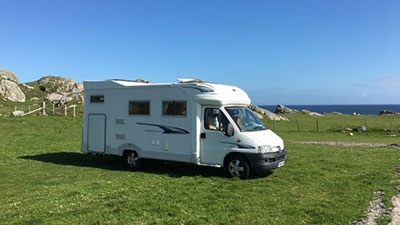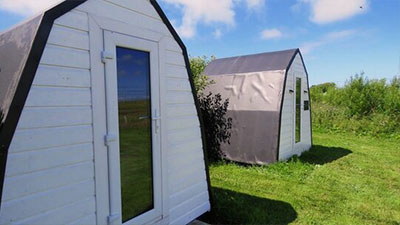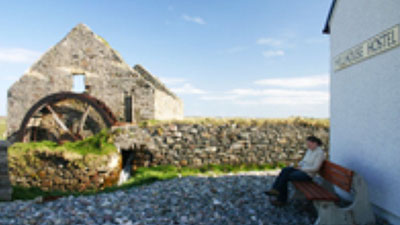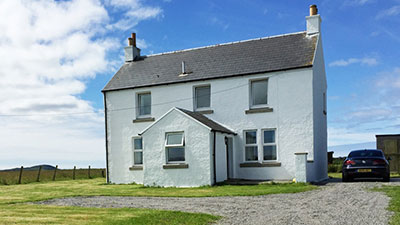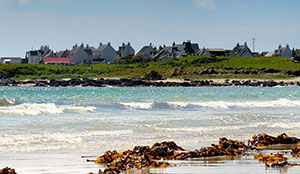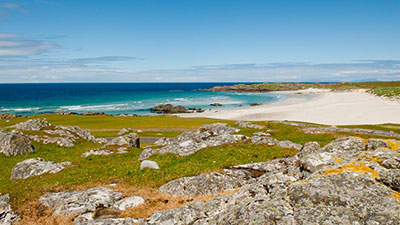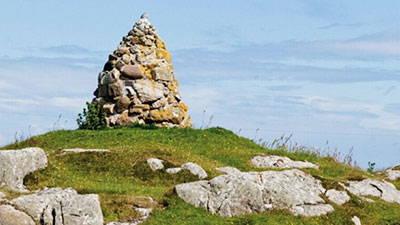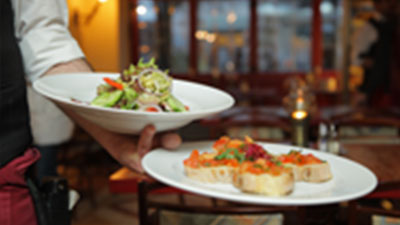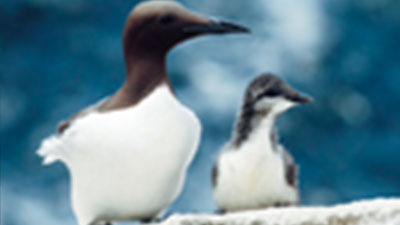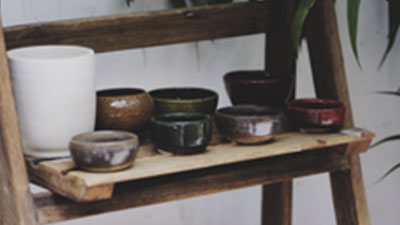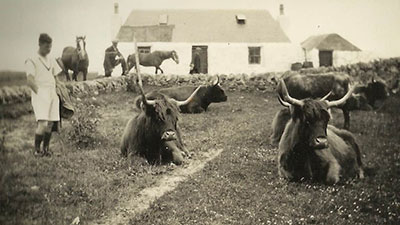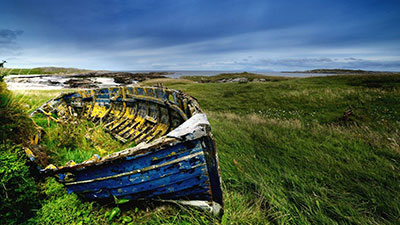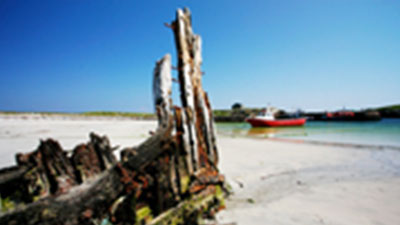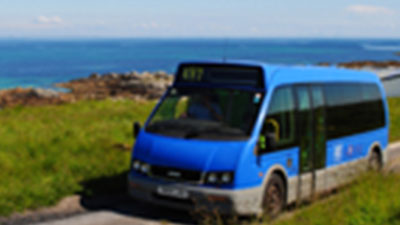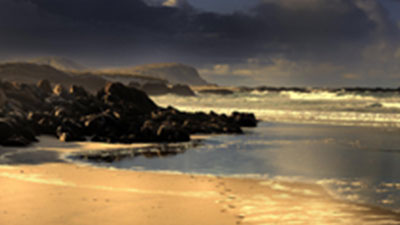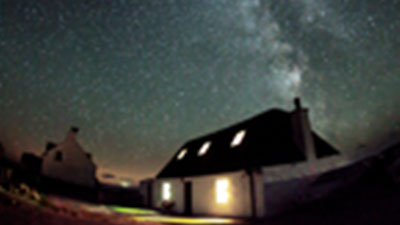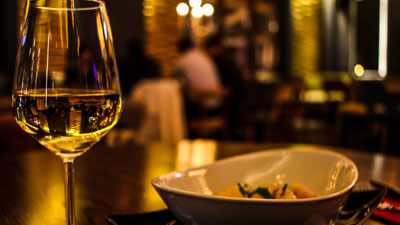Although Tiree is best known for its incredible range and abundance of birds, its rich habitats are also home to a wide range of other wildlife from rare bumblebees to huge Basking Sharks. In order to observe the full range of these fascinating animals, it is useful to become familiar with the dates and places that they are most often seen.
Butterflies
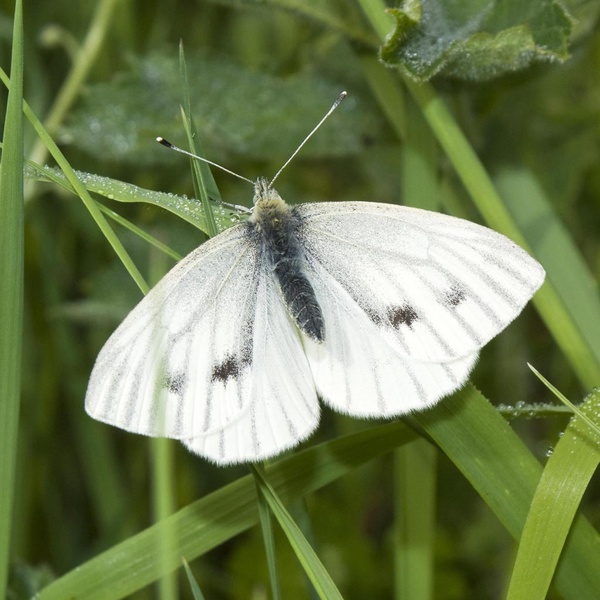
Islands are rather windy places for butterflies, but on calmer sunny days in summer, the flower-rich meadows can come alive with these fragile wanderers. Widespread species such as Green-veined White, Small Tortoiseshell and Meadow Brown occur in all the grasslands for most of the summer but you will need to check the dunes and machairs in July for the dazzling Common Blue. In some summers, large numbers of Painted Ladies and Red Admirals arrive from further south. These are joined by Large Whites in June/July and more rarely by Peacock butterflies. As summers warm up, we may see more of these and other butterflies arriving as their ranges spread northwards.
Dragonflies
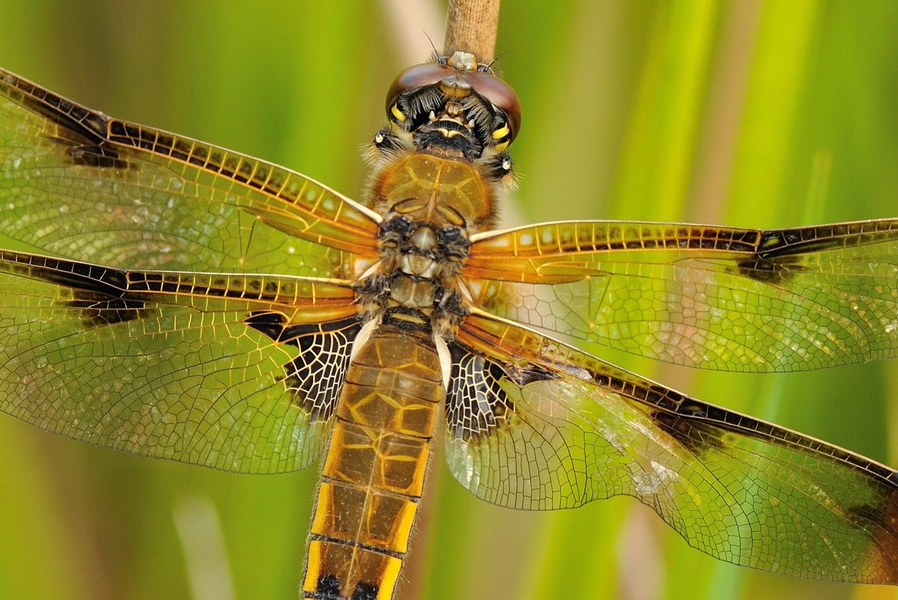
Tiree is home to a small range of dragonflies that haunt the wetlands. The Four-spotted Chaser is the first on the wing in late May and June – it prefers more acidic moorland pools such as those near the Ringing Stone. Highland and Black Darters follow in July and August – these species are more widespread and their feeding ranges include drier dunes, machair and gardens, as well as loch edges and marshes. The Blue-tailed Damselfly is widespread and common across the island, but the all-blue Common Blue Damselfly does not live up to its name, being more restricted to the edges of the larger lochs.
Bumblebees
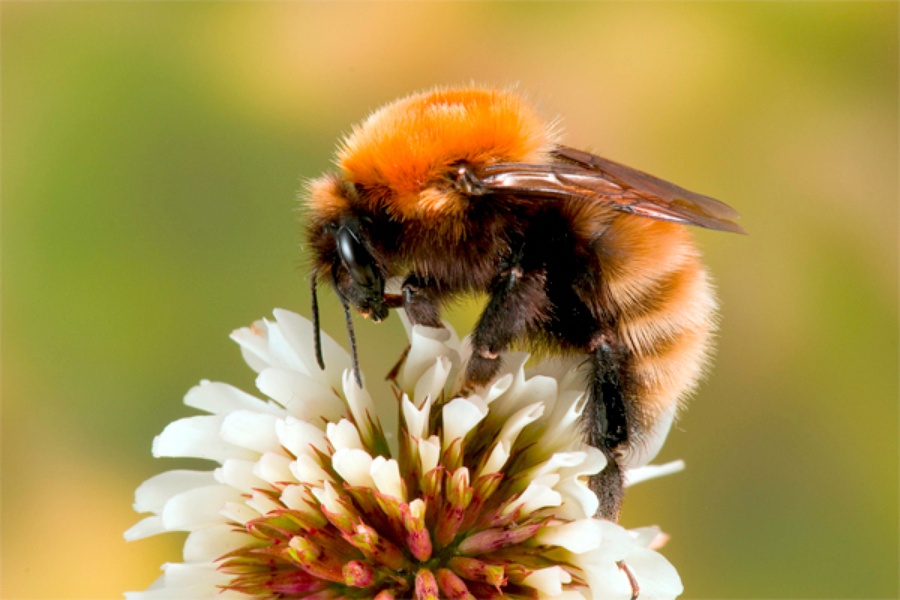
A total of nine species of bumblebee thrive on the flower-rich pastures of Tiree. The low intensity crofting agriculture suits bumblebees very well and Tiree boasts high densities of bees in July and August that are now scarce across much of the mainland. One of the most widespread bees is the Moss Carder Bee, which with its bright orange upper body and yellowish lower body, is a striking sight. This should not be confused with the scarce Great Yellow Bumblebee, which is all pale yellow with a broad black band across it upper body, and is more restricted to the machair. Another common bumblebee seen on Tiree is the Common Carder Bee. Barbut's Cuckoo Bumblebee can also be seen. Two species of red-tailed bumblebee occur - Red Tailed Bumblebee and the Red-shanked Carder Bee - both have all black bodies and red bottoms and are hard to tell apart. Similarly, there are three species of confusingly similar white-tailed bumblebees - White Tailed Bumblebee, Garden Bumblebee and Heath Bumblebe. All of them play a vital role in pollinating the myriad of flowers on the island.
Amphibians
Toads remain scarce on Tiree and are rarely seen. Frogs on the other hand have increased dramatically in recent years. Watch out for large numbers crossing roads at night in the vicinity of wet grassland e.g. along the Balemartine to Balephuil road or on the Cornaigmore road, particularly on wet mild nights in spring and autumn
Land Mammals
The most obvious land mammal is the Brown Hare, which occurs in large numbers all over the island. Tiree remains the largest Rabbit-free island in Britain. Beware young Hares, which can look rather rabbit-like but always lack the latter’s distinctive fluffy white tail. Hedgehogs were introduced to the island in recent years, but do not seem to reach the high densities here that they did on the Uists. They are most easily seen crossing roads at night on warm late summer evenings. Other mammals present include the Brown Rat, Field Mouse and the Pygmy Shrew, although all are rather elusive and rarely seen. There are occasional reports of bats on still summer evenings, but it is currently unclear which species are involved.
Sea Mammals
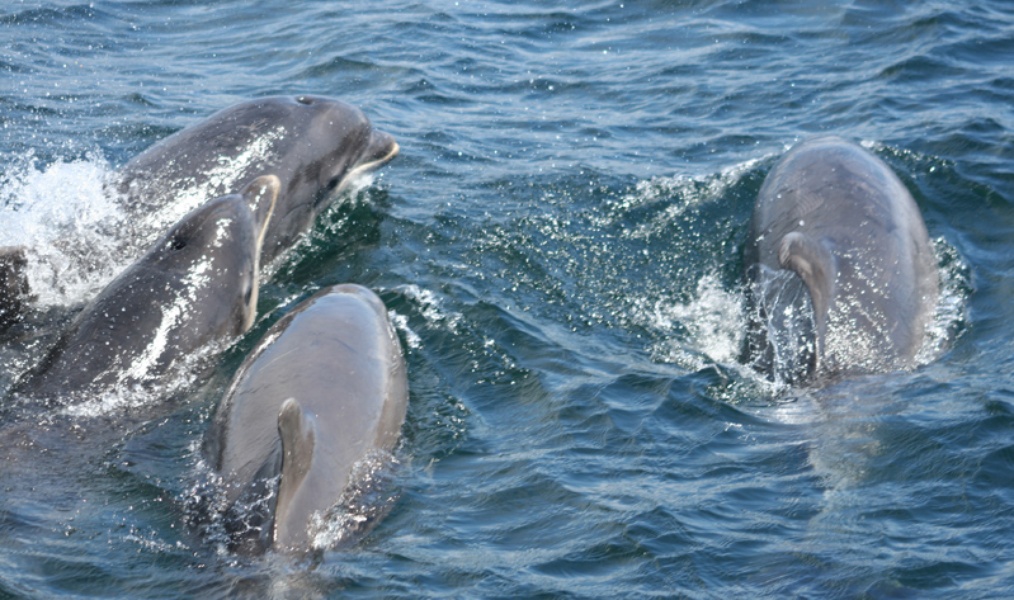
Grey Seals are numerous around the coast and are easily seen on skerries from the road-end at West Hynish or by taking a boat trip out to one of the many offshore islets. Smaller numbers can be seen in other bays, whilst Common Seals prefer the calmer waters of the bays at Vaul and Salum, as well as in Gunna Sound. Beware however, as the two species can often occur side by side and can be easily confused. The “roman nose” of the large bull Grey Seals is a distinctive feature to look out for. Often regarded as a sea mammal, the Otter is equally at home in the island’s lochs and ditches. Tiree holds a good number of otters, and their tracks are often to be seen on sandy beaches at the base of sand-dunes. Seeing the animals themselves is a matter of persistence and luck. Try the public hide at Loch Bhasapol – Otters can often be seen fishing for eels out in the middle of the loch – although often all that can be seen is the tail as they dive down from the surface.
Cetaceans and Basking Sharks
The shallow seas around the islands provide rich feeding grounds in summer. Basking Sharks have become increasingly numerous in recent years and are returning earlier and earlier each year. In 2006, peak numbers occurred in June/July, whereas in previous years the peak occurred in August. Tell-tale shark fins can be circling the island on calmer days from many places, but recent hot-spots have included West Hynish/Traigh Bhi, Hynish Bay from Hynish, Balemartine and Crossapol, and Gunna Sound from Caoles. Also watch out for these gentle giants from the CalMac ferry between Coll and Tiree. The ferry is also the best way of seeing cetaceans. Harbour Porpoises are the commonest cetacean and can be seen year-round, although numbers peak during the summer. Common Dolphins can turn up in large numbers, often in May/June, whilst the odd resident Bottle-nosed Dolphin can be seen with luck. Minke Whales prefer the deeper waters off SW Coll and at the entrance to the sound of Mull, whereas Killer Whales and larger dolphins such as Risso’s, White-beaked and White-sided Dolphins pass through from time to time on their way to and from the Minch, particularly in late summer.
Birds
The island of Tiree is a great place for bird-watching. Its rich machair grasslands, wet heath-lands and lochs host high densities of breeding waders, waterfowl and corncrakes, along with a wide range of smaller birds such as twites and stonechats. All these birds benefit from traditional crofting practices, which enhance the natural habitats. Terns and gulls nest widely around the island and the sea-cliffs at Ceann a' Mhara hold a classic Scottish sea-bird colony, which can be visited by boat. Bird interest is year-round, as the mild oceanic climate enables large numbers of waterfowl and waders to winter on the island, including some 8,000 barnacle, greylag and Greenland white-fronted geese, whilst the lochs are host to flocks of wintering ducks and swans and to resident greylags. Passage in spring and autumn is often very pronounced as birds stop off to feed on their way between Arctic breeding grounds and wintering areas further south. The island is an ideal place to watch bird migration in full swing. Tiree is significantly under-watched at such times and there is a good chance of the casual observer finding something new and interesting. Lying at the south end of the Minch, the island is well-placed for sea-watching and for boat trips to adjacent seabird islands, whilst the numerous rich shallow machair lochs and broad sandy beaches are highly attractive to migrant waders, ducks and gulls. Cover for smaller migrants is scarce at best but nettle patches and bushes in isolated gardens can provide temporary refuge for a surprising range of warblers, thrushes, flycatchers and chats.
The island welcomes visitors who respect property and farm animals, park sensibly and leave gates as they found them. Please be especially careful in the spring and early summer during lambing and when ground-nesting birds can be easily disturbed. Noisy parent birds usually mean that you are too close to a nest or brood, so please retreat to a safe distance and steer clear of obvious gull and tern colonies. When viewing gardens, do so discreetly, or better still, check with the owner if it's OK for you to look - many will be happy to talk about the birds in their gardens, but please respect the wishes of those that are more private. This guide lists some of the most productive sites - see map for locations - and some species to expect.
Sea Watching
Excellent sea-watching can often be had from the Oban-Tiree ferry. Between April and October, large numbers of gannets, guillemots, razorbills, kittiwakes, shags, fulmars and Manx shearwaters are sure to be seen together with smaller numbers of Arctic and common terns. Arctic and great skuas chase the feeding flocks and close checking during the summer should reveal smaller numbers of puffins and storm petrels, particularly out towards the Treshnish Isles and Skerryvore.
Westerly gales in autumn can produce leach's petrels, grey phalaropes and sooty shearwaters in amongst the commoner seabirds, whilst westerlies in late April-May can force pomarine skuas and more rarely long-tailed skuas to move up the passage between Tiree/Coll and Mull. Watch out for harbour porpoises, minke whales, common and bottle-nosed dolphins, whilst basking sharks can be quite numerous in summer. The best watching from the ferry is often just off Ardnamurchan Point and between Coll and Tiree. Summer boat tours visit Staffa and the Treshnish Isles with their teaming seabird colonies including good numbers of puffins, as well as the remote lighthouse of Skerryvore with its roosting seabirds and feeding storm petrels offshore.
Lochs
Loch a' Phuill • This large machair loch is difficult to approach in April-June because of high densities of breeding birds, however it is most productive for migrants in autumn. Best viewed from the public hide. Low water levels in the autumn create broad muddy/sandy fringes, which attract flocks of passage waders, mostly dunlins, ringed plovers and redshanks but black-tailed godwits, whimbrels and greenshanks are regular together with smaller numbers of scarcer species. The loch hosts large flocks of dabbling and diving ducks and these should be checked thoroughly for scarcities such as gadwall, pintail and scaup.
Large numbers of gulls visit the loch to wash and preen and these frequently include the odd glaucous and Iceland gulls between October and April, as well as kittiwakes from the nearby cliffs. The loch is also attractive to feeding terns and to aerial feeders such as swallows and sand martins in the summer, whilst the adjacent grasslands can hold large numbers of golden plovers during the winter. Otters can be seen from time to time, fishing for eels in this loch as well as at Loch Bhasapol and Loch an Eilein below.
Loch Bhasapol • Best viewed from the public hide. Better for breeding ducks than Loch a' Phuill and holds a large breeding colony of black-headed gulls in summer together with smaller numbers of Arctic terns. Large rafts of winter diving ducks include regular pochards and the odd scaup, plus occasional little and slavonian grebes. The reed-beds hold good numbers of sedge warblers and reed buntings, which in turn attract hunting hen harriers and buzzards. The gull flocks are worth checking for less common species, including little gulls which are near-annual.
Loch an Eilein • Park off the road at (NL987433) to view the east side, and at (NL983434) to view the west. This shallow loch is always worth a passing check. This is the most consistent site on the island for passage black-tailed godwits in April-May and for greenshanks and ruffs in July-September, plus small numbers of ducks and swans throughout the year.
Coastal Bays
All of the beaches and bays are worth a check, as the gull and wader flocks constantly move in search of the best feeding sites. Flocks of pale-bellied brents regularly stop off along the shore in both spring and autumn. The top three bays are:
Balephetrish Bay • Park along the track at the west end of the bay (NL995471) and view the beach for waders and the inshore waters for divers and duck. Large mixed flocks of sanderlings, ringed plovers and dunlins are present for much of the year and are joined by turnstones and purple sandpipers near rocky outcrops, plus smaller numbers of oystercatchers and bar-tailed godwits. This is a good spot for great northern divers between September and May. The sheltered western end of the beach is good for wagtails, chats and pipits including regular white wagtails in spring, whilst large gull flocks can appear in winter and spring.
Sorobaidh Bay • Long sandy bay, generally most productive at the southern end, but the north end is also worth checking. Park off the road opposite the cemetery (NL984416) and proceed on foot. Similar range of birds to Balephetrish Bay. Combine with Balemartine below.
Gott Bay • Broad 4km long sandy bay. Park off the road and view at the south end (NM039459) and again half way along near some rocks (NM052473). This bay often has the largest flocks of dunlins, ringed plovers, sanderlings and bar-tailed godwits from July to May, plus the odd knot. Little stint and curlew sandpiper are near annual in autumn. The shallow bay is good for feeding terns in summer, mostly little terns and Arctic terns, but the odd sandwich tern can appear on passage. The western end of the bay often holds a few pale-bellied brent geese in spring and autumn, plus a large flock of golden plovers in winter.
Hynish • Park in the car park (NL986393) and explore the area on foot. Migrants use the stone walls, walled gardens and nettle beds for cover.
Balemartine • The coastline south of Sorobaidh Bay is sheltered in westerlies and migrants haunt the shore, nettle beds and gardens. The area west of Balemartine towards Balinoe and Balephuil is one of the best for corncrakes and an evening stroll along the roads in May-July will produce lots of calling birds and hopefully a glimpse of one as they move between calling locations.
Heylipol Church • Park at the church (NL965433) and explore the extensive gorse patches. This site is best in spring when it often holds migrant warblers and flycatchers. Vaul • Roadside gardens here hold some of the best cover on the island and often host island scarcities such as goldcrests and spotted flycatchers in both spring and autumn, but have attracted fewer rarities than more westerly locations. The bay and beach are also worth a check.
Scarinish • The few garden trees and bushes in Scarinish are usually unproductive. Better cover lies to the north at The Manse, including gorse patches and a tiny wood-lot. Balephuil • The gardens and crofts in the SW corner of the island are amongst the most productive for migrant passerines and have gained a reputation for turning up rarities. Yellow-browed warblers have appeared annually in recent autumns.
Milton • The sheltered gardens and coastline near the harbour have turned up several surprises in recent years including kingfisher, red-backed shrike and little bunting
Cover for Smaller Birds
Birds typical of open grasslands such as skylarks, meadow pipits, pied wagtails, lapwings and starlings are abundant on the island. Thanks to recent conservation measures employed by the island's farmers and crofters, the rasping call of the corncrake is once again a typical summer sound on Tiree and birds can be seen with persistence and luck in any of the townships. Wheatears are common in rocky areas, whilst stonechats and linnets frequent the taller heath and gorse. Blackbirds, song thrushes, twites and house sparrows are widespread around the crofts whilst both collared and rock doves frequent farm buildings. Woodland birds such as tits occur only as vagrants, and only a handful of willow warblers breed each year.
Many other smaller birds can however be seen on passage, with small numbers of greenfinches, goldfinches and chaffinches remaining for the winter. The west coast of the island (Balevullin to Hynish) is the most productive for smaller migrants but cover is particularly scant. Warblers making landfall here can be found in areas of minimal cover but quickly move on. Check all sheltered patches but, as elsewhere, always use discretion around houses. Goldcrests can be numerous in early spring, and smaller numbers of willow warblers, chiffchaffs, blackcaps, whitethroats and garden warblers are annual. Redwings and fieldfares can appear in huge numbers in autumn and are often accompanied by smaller arrivals of continental blackbirds and song thrushes. On clear days, visible migration can include heavy diurnal passage of meadow pipits and skylarks together with smaller numbers of finches and both snow and Lapland buntings. Smaller migrants can be thin on the ground, but if there are blackcaps and goldcrests about, then there is always a chance of something more unusual such as a lesser whitethroat or a pied flycatcher. In some years, the island sees irruptions of northern forest birds such as crossbills, siskins and waxwings, although owing to a lack of suitable habitat these rarely stay for long. Despite being on the west coast, most migrant passerines arrive from the east so easterly winds offer the best chance of new arrivals.
Tiree has produced some first-rate rarities from Europe over the years such as roller, booted warbler and yellow-breasted bunting, and no doubt will continue to do so. American passerines are extremely rare but red-eyed vireo (2008) and northern parula (2010) have both been found recently, hinting at further possibilities.
Bird hides
There are two public hides on the island - both located near the largest lochs.
Loch a' Phuill
This large machair loch is difficult to approach in April-June because of high densities of breeding birds, however it is most productive for migrants in autumn. Best viewed from the public hide. Low water levels in the autumn create broad muddy/sandy fringes, which attract flocks of passage waders, mostly dunlins, ringed plovers and redshanks but black-tailed godwits, whimbrels and greenshanks are regular together with smaller numbers of scarcer species. The loch hosts large flocks of dabbling and diving ducks and these should be checked thoroughly for scarcities such as gadwall, pintail and scaup. Large numbers of gulls visit the loch to wash and preen and these frequently include the odd glaucous and Iceland gulls between October and April, as well as kittiwakes from the nearby cliffs. The loch is also attractive to feeding terns and to aerial feeders such as swallows and sand martins in the summer, whilst the adjacent grasslands can hold large numbers of golden plovers during the winter. Otters can be seen from time to time, fishing for eels in this loch as well as at Loch Bhasapol and Loch an Eilein below.
Loch Bhasapol
The public hide at Loch Bhasapol is great place to sit and watch wildlife in comfort and out of the weather. Set up and back from the loch, it provides a panoramic view of the open water and fringing marshes. Bring binoculars or telescopes to get closer views of the wide range of birds present. The hide is at its best in April/May when the loch is home to many pairs of breeding duck such as Mallard, Teal and Shoveler, large numbers of resident Greylag Geese, a pair of Mute Swans and dozens of pairs of Snipe, Redshank and Lapwing. The surrounding reed-beds are home to chattering Sedge Warblers, as well as Reed Buntings and noisy colonies of Black-headed Gulls and Arctic Terns. Keep an eye on the gulls and terns, as they will mob intruders such as passing birds of prey or otters. Watch out for scarcer spring migrants such as Black-tailed Godwits, Sand Martins and Swifts, whilst Little Gulls are probably annual. The loch quietens down later in the summer, but picks up again in winter as Arctic-nesting wildfowl such as Tufted Ducks, Wigeon, Goldeneye and Whooper Swans appear in large numbers. These are joined by Argyll’s only wintering Coots, plus small numbers of elusive Little Grebes and Moorhens. Otters are present all year round and can be seen with luck and patience.
The hide is located at NL966466 and can be accessed on foot via a sign-posted kissing gate off the road to Kilmoluaig. There is a small parking area on the right hand side of the road in front of a low ruin (NL965467) just before the hide is reached. Please do not park on the road itself or in the nearby passing places.

